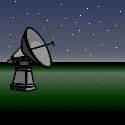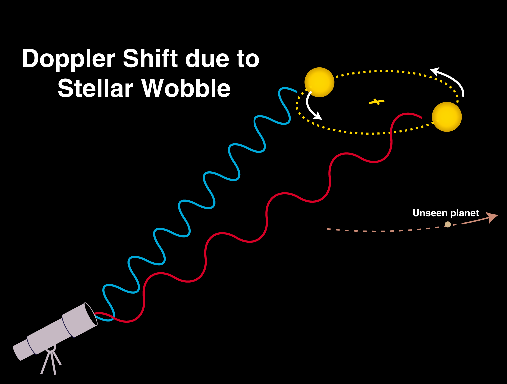The universe is alive with cosmic noise. And these natural celestial noise levels in the universe can make it a very noisy place for a radio telescope. To devise a search strategy we would have to make certain assumptions. Any civilization transmitting a signal with the intention that it would be detected by another civilization would most likely chose a transmitting frequency that they would expect the receiving civilization to be scanning for. You would also assume that the signal should be transmitted in a radio frequency band where there is minimum noise. As it happens, there is such a frequency region, and it has become known as the Cosmic Waterhole.
It lies between the neutral Hydrogen (H) radio emission frequency line of 1420MHz and the Hydroxyl (OH) line of 1662MHz. So with the obvious connection of the 'H' and the 'OH' which combine to form water (H20), essential to all life, the fact that Hydrogen is by far the most common element in the universe, and the fact that this frequency region means a signal stands the best possible chance of achieving its purpose by having greater penetration through interstellar space, we assume that this would be the frequency of choice by scientists in any civilization, or certainly ones with similar technology to ours. These are, after all, characteristics of the universe and not specific to our region of space. So in hopeful anticipation it became known as the cosmic waterhole, named after the African waterhole, a place where different species meet. So searching in this frequency band should increase the chances of detecting a signal.
There is also 'leakage' signals emitted, such as our own TV and Radio transmissions (also Radar) emitted over the last 70 years or so. But the intensity of these signals would unlikely be strong enough to be detected above the background noise over extremely long distances. However it is thought that these signals would be detected by a civilization with our technological ability up to perhaps 100 light years distant (assuming they were looking in the right direction). But if aliens can watch our television, we may have a problem according to Astronomer Carl Sagan, in his book Contact. He suspects that the first high-powered television broadcast that aliens would pick up would be Hitler's broadcasts at the Nuremberg rallies! If Sagan is right then maybe they will stop looking in our direction. Then again 'I love Lucy' maybe the first broadcast they will pick up. Here's hoping!
Planet Searching
Just to state the obvious, it's probably advisable to rule out searching for intelligent life in our own solar system. Certainly there may be life - but not intelligent life.
As far as we know life can't exist without water. So where you find water in the universe you have a possibility of finding life. And scientists have found evidence that Europa (Jupiter's icy moon) may have an ocean of liquid water beneath its icy surface. So Europa is a strong possibility, as is Mars, if not for simple forms of life than perhaps just evidence that simple forms of life once existed. We should find out in the not too distant future. But as regards intelligent life .....
Directly viewing a planet around another star (extra solar planet) is comparable to trying to view a grain of sand on the moon, a very very challenging task. But thanks to gravity, we can detect a planet orbiting a distant star by the minuscule wobble it creates on the star. In 1995 the first planet was found this way. Now, up to two or three a month are found. There is close to 300 discovered towards the end of 2007, with many more suspected but as of yet not confirmed. It is truly a very interesting and exciting era in the world of astronomy. But with current technology we cannot tell if any type of life exists on these planets. A number of programs are underway which should tell us much more and should be able to look directly at planets rather than just relying on the wobble of a star to tell us a planet exists. These programs will analyse the planet's atmosphere and perhaps tell us whether there is life.

Should our quest for extra-terrestrial life be directed at Sun-like-stars. Probably yes, since larger stars have shorter lifetimes and therefore 'life' as we know it might not have enough time to evolve. Small stars provide so little heat that only planets very close to the star would provide conditions for life to evolve, however being so close may mean being tidally locked (taking the same length of time for the planet both to rotate on its axis and to revolve around the star) which would prevent evolution of life as one side of the planet would be too hot and the other side too cold. About 10% of the stars in our Galaxy are sun-like.
NASA is planning to launch the Terrestrial Planet Finder (TPF) in 2012. This project will help scientists locate earth-like planets orbiting sun-like stars and determine whether they have the ability to support life. While most planets discovered so far are gas giants similar to Jupiter, known as hot Jupiter's, current planet formation theory suggests that smaller rocky planets should be more numerous that gas giants. But because of their smaller mass most of them are currently undetectable. So finding extra-terrestrial life may take along time, but at least we are beginning to zoom in on likely places that offer optimism.
Methods of Detection
Currently the best technique to search for extra solar planets is Doppler Spectroscopy. When a planet orbits a star it creates what's called a 'stellar wobble'. Essentially this wobble is caused by both objects orbiting a common center of gravity. And when we measure the wavelength of the light emitted by the star it is Doppler shifted as it moves away and towards us, around this common center of gravity. This Doppler shift is usually the tell-tale sign of an unseen companion, a planet. However we may have to wait a while before an Earth-sized rocky planet is detected.
 To date all the planets detected are hot gas giants similar to Jupiter. However, the planet HD 209458b offers new hope. This planet orbits an 8th magnitude star, 150 light years from Earth, in the constellation of Pegasus. In 2004 an atmosphere containing oxygen and carbon was detected. And more recently, in 2007, evidence points to the atmosphere possibly containing water vapour!
To date all the planets detected are hot gas giants similar to Jupiter. However, the planet HD 209458b offers new hope. This planet orbits an 8th magnitude star, 150 light years from Earth, in the constellation of Pegasus. In 2004 an atmosphere containing oxygen and carbon was detected. And more recently, in 2007, evidence points to the atmosphere possibly containing water vapour!
And more recently the Gliese 581 solar system, 20 light years away, and planet g in particular, discovered in September 2010, seems even more promising as this planet is thought to be a rocky planet orbiting in the habitable zone, making it a good contender to have liquid water on the surface! In October 2008 a digital signal was sent to the planet Gliese 581c. It will take about 20 years to reach it's intended destination, and if anybody receives it and chooses to reply we can expect a return signal by about 2049. We await with bated breath for what will definitely be mankind's greatest discovery.
Pulsar timing and Photometry are two other methods used to detect extra solar planets, which we will look at later.

